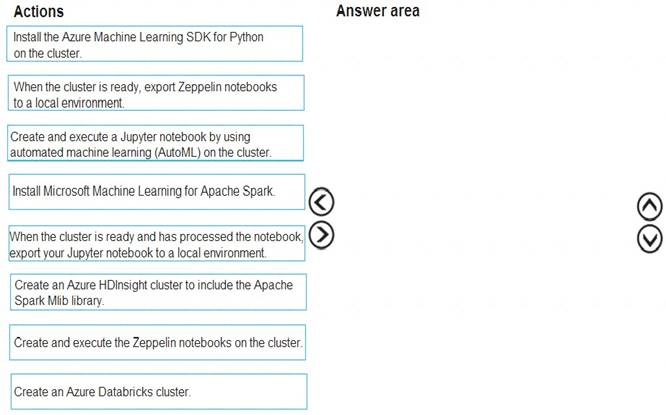- (Exam Topic 3)
You are evaluating a completed binary classification machine. You need to use the precision as the evaluation metric.
Which visualization should you use?
Correct Answer:
C
Receiver operating characteristic (or ROC) is a plot of the correctly classified labels vs. the incorrectly classified labels for a particular model.
References:
https://docs.microsoft.com/en-us/azure/machine-learning/how-to-understand-automated-ml#confusion-matrix
- (Exam Topic 2)
You need to configure the Permutation Feature Importance module for the model training requirements. What should you do? To answer, select the appropriate options in the dialog box in the answer area. NOTE: Each correct selection is worth one point.
Solution:
Box 1: 500
For Random seed, type a value to use as seed for randomization. If you specify 0 (the default), a number is generated based on the system clock.
A seed value is optional, but you should provide a value if you want reproducibility across runs of the same experiment.
Here we must replicate the findings. Box 2: Mean Absolute Error
Scenario: Given a trained model and a test dataset, you must compute the Permutation Feature Importance scores of feature variables. You need to set up the Permutation Feature Importance module to select the correct metric to investigate the model’s accuracy and replicate the findings.
Regression. Choose one of the following: Precision, Recall, Mean Absolute Error , Root Mean Squared Error, Relative Absolute Error, Relative Squared Error, Coefficient of Determination
References:
https://docs.microsoft.com/en-us/azure/machine-learning/studio-module-reference/permutation-feature-importan
Does this meet the goal?
Correct Answer:
A
- (Exam Topic 3)
You use the Azure Machine Learning SDK in a notebook to run an experiment using a script file in an experiment folder.
The experiment fails.
You need to troubleshoot the failed experiment.
What are two possible ways to achieve this goal? Each correct answer presents a complete solution.
Correct Answer:
BD
Use get_details_with_logs() to fetch the run details and logs created by the run.
You can monitor Azure Machine Learning runs and view their logs with the Azure Machine Learning studio. Reference:
https://docs.microsoft.com/en-us/python/api/azureml-pipeline-core/azureml.pipeline.core.steprun https://docs.microsoft.com/en-us/azure/machine-learning/how-to-monitor-view-training-logs
- (Exam Topic 3)
Note: This question is part of a series of questions that present the same scenario. Each question in the series contains a unique solution that might meet the stated goals. Some question sets might have more than one correct solution, while others might not have a correct solution.
After you answer a question in this section, you will NOT be able to return to it. As a result, these questions will not appear in the review screen.
You train and register a machine learning model.
You plan to deploy the model as a real-time web service. Applications must use key-based authentication to use the model.
You need to deploy the web service.
Solution:
Create an AksWebservice instance.
Set the value of the auth_enabled property to False.
Set the value of the token_auth_enabled property to True.
Deploy the model to the service. Does the solution meet the goal?
Correct Answer:
B
Instead use only auth_enabled = TRUE Note: Key-based authentication.
Web services deployed on AKS have key-based auth enabled by default. ACI-deployed services have
key-based auth disabled by default, but you can enable it by setting auth_enabled = TRUE when creating the ACI web service. The following is an example of creating an ACI deployment configuration with key-based auth enabled.
deployment_config <- aci_webservice_deployment_config(cpu_cores = 1, memory_gb = 1,
auth_enabled = TRUE) Reference:
https://azure.github.io/azureml-sdk-for-r/articles/deploying-models.html
- (Exam Topic 3)
You are building an intelligent solution using machine learning models. The environment must support the following requirements: Data scientists must build notebooks in a cloud environment
Data scientists must build notebooks in a cloud environment Data scientists must use automatic feature engineering and model building in machine learning pipelines.
Data scientists must use automatic feature engineering and model building in machine learning pipelines. Notebooks must be deployed to retrain using Spark instances with dynamic worker allocation.
Notebooks must be deployed to retrain using Spark instances with dynamic worker allocation.  Notebooks must be exportable to be version controlled locally.
Notebooks must be exportable to be version controlled locally.
You need to create the environment.
Which four actions should you perform in sequence? To answer, move the appropriate actions from the list of actions to the answer area and arrange them in the correct order.
Solution:
Step 1: Create an Azure HDInsight cluster to include the Apache Spark Mlib library
Step 2: Install Microsot Machine Learning for Apache Spark You install AzureML on your Azure HDInsight cluster.
Microsoft Machine Learning for Apache Spark (MMLSpark) provides a number of deep learning and data science tools for Apache Spark, including seamless integration of Spark Machine Learning pipelines with Microsoft Cognitive Toolkit (CNTK) and OpenCV, enabling you to quickly create powerful, highly-scalable predictive and analytical models for large image and text datasets.
Step 3: Create and execute the Zeppelin notebooks on the cluster
Step 4: When the cluster is ready, export Zeppelin notebooks to a local environment. Notebooks must be exportable to be version controlled locally.
References:
https://docs.microsoft.com/en-us/azure/hdinsight/spark/apache-spark-zeppelin-notebook https://azuremlbuild.blob.core.windows.net/pysparkapi/intro.html
Does this meet the goal?
Correct Answer:
A

